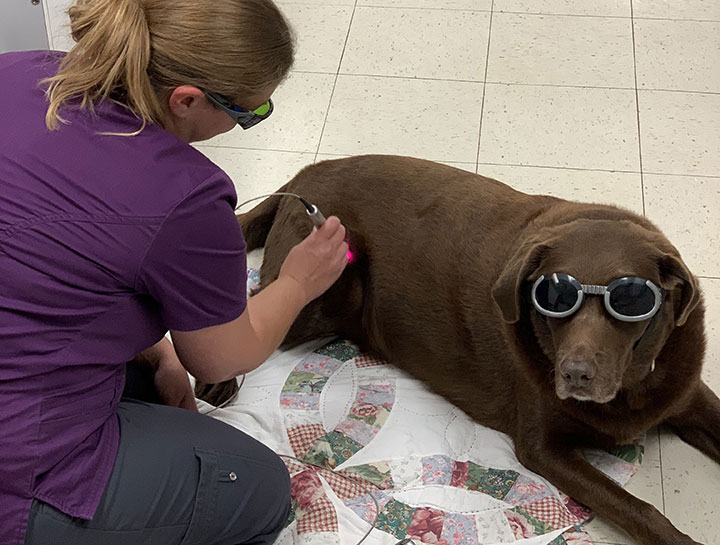Follow-up treatments as needed every 3uptreatments as needed every 3. The result is a reduction in swelling which reduces pain.
Treatment of osteoarthritis OA in dogs and cats using therapeutic laser is commonly described.

Canine laser treatment. The laser therapeutic value is in how much energy it delivers joules. Used similarly to acupuncture massage therapy and other alternative therapies laser treatment can be used in conjunction with or in place of medication to manage pain inflammation and wound healing. Finally tendonitis may benefit from laser therapy due to the inflammation associated with the condition.
In the fourth randomised controlled study 12 dogs received hemilaminectomy surgery and were randomly assigned to a laser treatment group or control group Wardlaw et al 2019. Cold laser therapy is also known as soft laser therapy low power laser therapy low level laser therapy bio-stimulation laser therapy therapeutic laser therapy and LLLTCold laser therapy is a treatment that uses a low-powered laser that does not produce heat to treat conditions and injuries in dogs. The use of GaAlAs laser was compared with bone morphogenetic protein BMP and bovine organic bone graft in a rat femoral bone healing model.
Six treatments with Companion Laser over three weeks. A session is normally between 15 and 45 minutes and initially a course is recommended of 1 to 2 sessions a week. The laser dose that may be most appropriate in OA is 8 Jcm2 to 10 Jcm2 applied as part of a multi-modal arthritis treatment plan.
But they did respond when treated with Low Level Laser Therapy using a proven effective laser used by someone knowledgeable about what settings to use and where to treat she says. BMPs plus organic bovine bone graft. At Muller Veterinary Hospitals Canine Rehabilitation Center in Walnut Creek California Erin Troy DVM has worked with canine patients who did not appear to benefit from home laser devices.
It is also used on other domestic pets horses and humans. Laser treatments can also be used for quite a wide range of things including helping dogs to recover faster after surgery in some cases too. 44 Rats were assigned to four groups.
And BMPs plus organic bovine bone graft plus laser treatment. Qualitative assessment of wound photographs demonstrated that laser therapy-treated dogs had improved scar scales with a statistically significant difference by day 21 when compared to control dogs. Laser therapy is used for everything from arthritis to ligament injuries nerve damage to ear and skin infections and inflammation.
Although arthritis can be controlled with the administration of certain joint supplements that contain glucosamine and chondroitin the symptoms of arthritis return once these supplements are discontinued. Canine Arthritis Laser Treatment Arthritis laser treatment is a new treatment procedure thats used to help dogs suffering from arthritis. The laser-irradiated groups received treatments every 48 hours for seven treatments.
Hot laser treatments come with greater risk of cutting andor burning caused by the increased intensity of laser beams. No change in additional therapy during initial laser treatment Followtreatment. A laser-certified technician is likely to do the treatments on your dog which last about 15-30 minutes each depending on the issue location and the dog.
Treating a comprehensive area will ensure a more consistent outcome. Laser therapy is used to treat a variety of medical conditions in dogs. Laser therapy reduces pain by reducing inflammation through Òvasodilation the opening of blood vessels and also by activating the lymphatic drainage system thus draining swollen areas.
Laser light is targeted to key areas during a treatment session which may be the joint and areas of obvious compensatory change. LASER means Light Amplification by Stimulated Emission Rays. Can laser treatment improve other canine health conditions too.
A class 4 laser will deliver 3500 joules of energy in that time with a treatment depth of 15 cm. Veterinary laser therapy is an innovative treatment that has gained popularity in recent years as veterinarians discover its benefits for pets. Cold laser therapy is a noninvasive procedure that uses light to stimulate cell regeneration and increase blood circulation.
Lower-powered lasers less than 1 W can use a point-to-point method in which a dose is delivered for up to 30 seconds in 1 location before the probe is moved. Lasers are beams of light travelling at predetermined frequencies that penetrate tissues. Laser treatments are an excellent way to provide pain relief to your canine companion.
Cold laser therapy treats the surface of the skin while hot laser treatments affect deeper tissues. If your clinic offers laser treatments or theres a clinic in your area that does they will be able to talk you through the various applications and options. Treatment technique will vary with the laser used.
For example a 5 minute treatment with a cold laser will deliver maybe 150 joules at a treatment depth of 3 cm.
